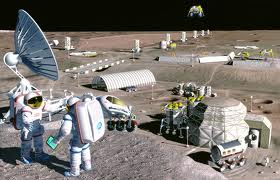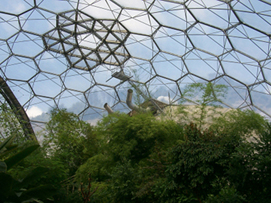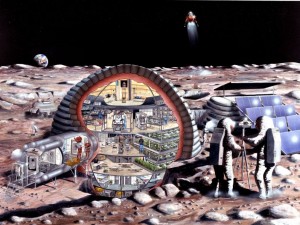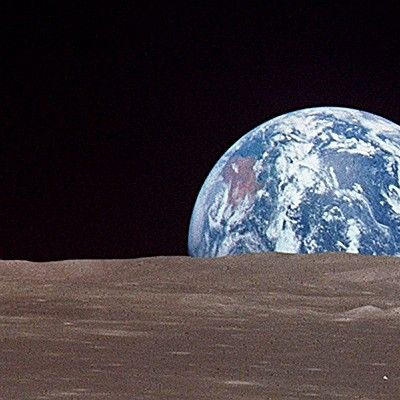Why will humans land on the Moon in the 21st century? Will we create permanent habitations there? What are the benefits? How many of us will become lunar citizens?
The Apollo Program developed technology to send two humans to the surface of the Moon for short stays. The technology included temporary habitation and wheels to move around and explore. All the resources needed, from air, water, food and energy had to be transported from the gravity well that is Earth. Flush with funds from Cold War budgets, the U.S. space program headed by NASA, expended the capital to achieve within one decade this amazing feat. But Apollo was unsustainable. So when we return to the Moon in this and the next decade economics will determine how we do it. And we will begin with robotic landers and rovers similar to those we have successfully used on Venus and Mars. And we will be going because the Moon possesses “stuff” we need in pursuing our outward urge to explore the Solar System and beyond. But what we won’t be doing is the “picnic” approach of the Apollo Program. We will need bio-regenerative technology capable of supporting autonomous lunar settlement.
10 Reasons to Go Back to the Moon
- The Moon can be a base for exploring the Solar System. The Moon’s gravity well is much less than that of Earth. That means the energy requirements to get to other places from the lunar surface is a fraction of what we would need if we were to launch from Earth or in near-Earth orbit.
- The Moon would be a good base for operating mining of near-Earth asteroids.
- The lunar environment lends itself to vacuum manufacturing of high-value products that could be imported by Earth.
- Humans can do science on the Moon that cannot be duplicated on Earth or in near-Earth orbit.
- The Moon’s far side is an ideal radio astronomy site with no noise from Earth to pollute the signal. Optical telescopes much bigger than Hubble can be manufactured and placed on the lunar surface to increase our visual understanding of the cosmos as well.
- The Moon is a natural source of Helium-3, an important element needed for nuclear fusion reactors. 25 tons of the stuff could yield enough energy to power the United States for one year. Based on our studies of lunar geology the Moon has more than 1.1 million tons of the stuff deposited on its surface by the solar wind, equal to 10 times the amount of energy we would derive from all the fossil fuels here on Earth. At current valuation, $3 billion a ton, Helium-3 gives us considerable lunar motivation.
- The Moon is a great near-Earth environment for building the technologies and self-supporting habitats and infrastructure that we will need when going to places like Mars.
- The Moon can be the centre for launching space-based industries. It has the raw materials. It has unfettered access to the Sun for generating solar power which can be transmitted to Earth.
- The Moon is an ideal place for doing the kinds of experimentation that would be considered hazardous in the environment of Earth.
- The Moon is a great location to study Earth, not just through remote sensing, but also by studying remnants of Earth lying on the surface of the Moon that can give us a better picture of Earth’s beginnings and its remote geological history.

Could much of what is described above be done using artificial intelligence and robots? Yes.
Would it make more sense to dehumanize our lunar presence? Yes and No. Yes in the sense that there would be no human risk, just an investment in technology and the spinoffs that we would derive from innovation. No in that the experience would not be ours. Some argue that virtual presence is almost the same as being there. But there are those being born today who will jump at the chance to become members of lunar colonies in the 21st century.
How Humans Will Live on the Moon
It is important to acknowledge that any permanent human presence on the Moon requires developing closed loop bio-regenerative systems that work autonomously without intervention and resupply from Earth. If this cannot be achieved lunar colonization will fail. To be successful lunar colonies will have to develop:
- Food production systems – the lunar colony must produce its own food, maximizing the use of the biomass it creates through consumption and recycling
- Human habitation systems – the housing of humans has to include self-sustaining provision of water, oxygen, nitrogen, and the management and recycling of waste
- Energy and light systems – must provide efficient photosynthetic lighting, and sufficient heating, cooling and power for lunar habitation, farming and industries
- Industrial and manufacturing processes – must be developed to provide high-value gainful employment for lunar colonists
- Government – the lunar colony will not be a national enterprise and will need to become self-governing
Bio-regenerative Earth-based experiments have not been all that successful. Remember Biosphere 2, the self-contained environment built in Oracle, Arizona, that attempted to create a closed-loop system modeled on Earth. Once built, Biospherians entered the complex and sealed themselves off from the outside. Two missions, one in 1991 and the other in 1994, illustrated the difficulties in getting the balance right. But unlike Biosphere 2, rescuing the inhabitants of a failed closed-loop system on the Moon is not a simple question of unsealing the habitat and walking out the door. Getting it right will be critical.

So how much edible biomass is required to support one human on the Moon? In terms of plant growing capacity, scientists estimate approximately 50 square meters (540 square feet). Think of an area about the size of large room (27′ x 2o’) and you get the idea. So any habitation we build on the lunar surface will have to accommodate a significant greenhouse for growing edible and non-edible plants. Why the latter? Because some plants may serve a symbiotic purpose to create more healthy edible plants, or be useful in purifying water, or better in absorbing CO2 and generating oxygen. Greenhouses can be tiered to save space with plants on rotational belts to move them for maximizing lighting conditions. And the growing medium for plants will largely be hydroponic. So on the lunar surface farmers will be invaluable.
Waste management will be a science and technology enterprise almost equal in significance to farming. Waste managers in a bio-regenerative environment will look after balancing the recycling of solid and liquid waste, composting and aquaculture to create freshwater and fish as a food source.
In addition lunar habitation will need to be designed to withstand the high radiation hazards of the lunar surface. The Apollo astronauts in their space suits, and the Lunar Excursion Module (LEM) were exposed to cosmic rays throughout each mission. But these missions were picnics – short term outings. Lunar inhabitants will need shielding against cosmic rays, solar storms and the solar wind.
And finally lunar habitations will need to deal with the potential of bacterial and viral pathogens evolving in the new environment of the Moon. So getting a good handle on microbial ecology will be an important job for lunar medical personnel.
So many of the jobs created for lunar colonization will be focused on supporting life in an autonomous bio-regenerative habitat.

Inhabiting the moon won’t be easy. No frontier can compare to the challenges humans will face in overcoming the lunar environment. By 2100 we will see several lunar settlements. The sites won’t be anywhere near where Apollo astronauts landed. The sites will be large because growing food crops will require a considerable amount of space. Fortunately there is no lack of real estate in which to expand. All sites will be modular and individually bio-regenerative so that each can stand alone.
Polar and near polar regions will be the ideal choices for habitation. The South Pole is particularly attractive because of the recent discovery of water ice in deep craters. The presence of water meets key criteria for lunar self sufficiency. Polar locations will also be more easily sheltered from solar storms and the solar wind. Most of the habitation materials including photovoltaics for energy generation could be manufactured at the site and assembled into solar arrays to provide power to the colony. Such a site would be ideal for communication with Earth as well since the signaling system would never disappear behind the Moon during the monthly lunar cycle.
The lunar census of 2100 will have a head count approaching 100,000. Every day as the lunar colonists go about their daily lives they will look up at the inky blackness above them and see Earth. That view will inspire them as it has the generations that followed Apollo.
















Seems highly unlikely that humans will ever establish a manned colony on the moon. The costs will always outweigh the benefits. It does seem likely sentient robots that mind/meld with humans back on Earth will inhabit, explore, and exploit, the moon. The one-way real-time communication delay to the moon is only about one second. For most purposes it’s trivial. That would not be the case for activities near Mars or the Asteroid Belt. In initial stages of development, a handful of humans might need to journey there to virtual reality mind meld with robot agents. Seems likely that by the year 2100 robot sentience/intelligence will vastly exceed that of humans.
Hi Al, As much as I believe that human and machine intelligence will develop a symbiotic relationship my conviction and prediction is we will not limit ourselves to machine presence as we explore the near Solar System. I can see us viewing Titan through the eyes of machine, but not the Moon and Mars. I do believe thinking machines will play a significant role in our presence on the Moon and Mars. It will be interesting to see how humans in interacting with a thinking machine world recognize the rights of the latter over time. I imagine citizenship on Mars and the Moon will include a recognition of machines as equal partners in the development of these off-Earth worlds.
I agree with 10 points to estd Lunar base.
Its doable
Build base within lunar soil & underground leaving portals for Comm, Solar arrays, spacedock, launch ports & airlocks alone.
Prefab whole base
See Reaction Eng Trojan Mars Base concept as model for Lunar base
Pre deploy Hab modules for crew.
See Skylon Mach 5 spaceplane.
I think lenrosen4’s vision is accurate as to how things will unfold, but I’m not so sure about the timeline of all these things coming together as early as 2100.
I firmly believe that in order to explore (and eventually colonize) with manned missions into deep space, we must first establish a permanent and self-sufficient presence on the Moon. It should be the obvious first step, but there are millions of people who insist that, with regards to the Moon, that we’ve, “been there, done that”, and that we should rashly just go on a one-off trip to Mars. Why? Just to say, “We did it!”?
These people have no clue, in my opinion, and they lack historical perspective. We as yet have no capability for manned long-duration presence in cold and hostile space. Furthermore, after the adrenalin from a dramatic Mars landing subsides and the public once again loses interest, the space program will atrophy once again as we spend another half century goofing around in Low Earth Orbit.
We need a steady, logical, step-by-step program of establishing permanent and self-sufficient bases on the Moon. As said above by loren4 in exquisite detail, it will be our proving and learning ground; our logical platform for going deeper into the Solar System, and developing and evolving a space faring economy and civilization. We’re lucky to have a sizable moon (we probably wouldn’t be here without it), and it may indeed prove to be an even more profound part of our ultimate destiny: to bring life to lifeless planets, and not just human life.
I foresee a gradual but ultimate developing human presence on the Moon and elsewhere as the centuries pass. After a time, as the moon bases become self-sufficient and lunar launch capabilities are developed, we will then (and only then) begin venturing to Mars, the Asteroid Belt, and beyond. It will be a slow, steady, evolving enterprise.
Meanwhile, technology will continue to exponentiate and accelerate. As the lunar bases mature and become prosperous and profitable to both free enterprise and governments, the Mars colonies will be taking hold and developing on their own. Once this whole scenario gets started, I believe that there will be no stopping it. It will gain its own momentum, and not only the human race, but as much of the diversified life on Earth that we take with us will be forever safe from extinction due to planetary catastrophes or even, billions of years into the future, the death of Sol, our beloved Sun!
[…] We wouldn’t stand a chance of surviving without bringing a micro version of the contents of Earth bubbles along with us. And even then, external forces could lead to our early […]